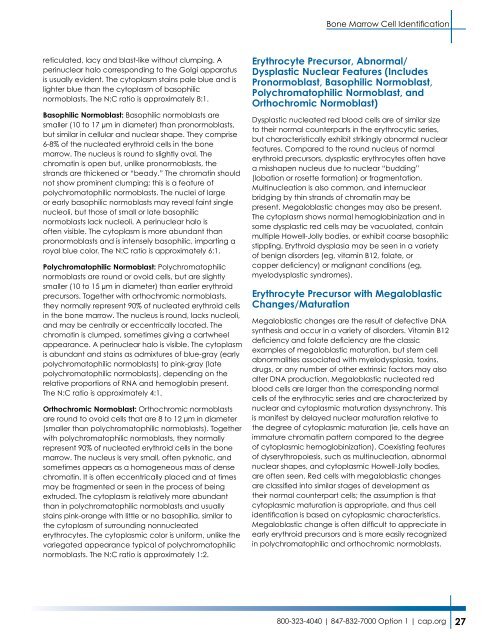Hematology and Clinical Microscopy Glossary - College of American ...
Hematology and Clinical Microscopy Glossary - College of American ...
Hematology and Clinical Microscopy Glossary - College of American ...
You also want an ePaper? Increase the reach of your titles
YUMPU automatically turns print PDFs into web optimized ePapers that Google loves.
eticulated, lacy <strong>and</strong> blast-like without clumping. A<br />
perinuclear halo corresponding to the Golgi apparatus<br />
is usually evident. The cytoplasm stains pale blue <strong>and</strong> is<br />
lighter blue than the cytoplasm <strong>of</strong> basophilic<br />
normoblasts. The N:C ratio is approximately 8:1.<br />
Basophilic Normoblast: Basophilic normoblasts are<br />
smaller (10 to 17 μm in diameter) than pronormoblasts,<br />
but similar in cellular <strong>and</strong> nuclear shape. They comprise<br />
6-8% <strong>of</strong> the nucleated erythroid cells in the bone<br />
marrow. The nucleus is round to slightly oval. The<br />
chromatin is open but, unlike pronormoblasts, the<br />
str<strong>and</strong>s are thickened or “beady.” The chromatin should<br />
not show prominent clumping; this is a feature <strong>of</strong><br />
polychromatophilic normoblasts. The nuclei <strong>of</strong> large<br />
or early basophilic normoblasts may reveal faint single<br />
nucleoli, but those <strong>of</strong> small or late basophilic<br />
normoblasts lack nucleoli. A perinuclear halo is<br />
<strong>of</strong>ten visible. The cytoplasm is more abundant than<br />
pronormoblasts <strong>and</strong> is intensely basophilic, imparting a<br />
royal blue color. The N:C ratio is approximately 6:1.<br />
Polychromatophilic Normoblast: Polychromatophilic<br />
normoblasts are round or ovoid cells, but are slightly<br />
smaller (10 to 15 μm in diameter) than earlier erythroid<br />
precursors. Together with orthochromic normoblasts,<br />
they normally represent 90% <strong>of</strong> nucleated erythroid cells<br />
in the bone marrow. The nucleus is round, lacks nucleoli,<br />
<strong>and</strong> may be centrally or eccentrically located. The<br />
chromatin is clumped, sometimes giving a cartwheel<br />
appearance. A perinuclear halo is visible. The cytoplasm<br />
is abundant <strong>and</strong> stains as admixtures <strong>of</strong> blue-gray (early<br />
polychromatophilic normoblasts) to pink-gray (late<br />
polychromatophilic normoblasts), depending on the<br />
relative proportions <strong>of</strong> RNA <strong>and</strong> hemoglobin present.<br />
The N:C ratio is approximately 4:1.<br />
Orthochromic Normoblast: Orthochromic normoblasts<br />
are round to ovoid cells that are 8 to 12 μm in diameter<br />
(smaller than polychromatophilic normoblasts). Together<br />
with polychromatophilic normoblasts, they normally<br />
represent 90% <strong>of</strong> nucleated erythroid cells in the bone<br />
marrow. The nucleus is very small, <strong>of</strong>ten pyknotic, <strong>and</strong><br />
sometimes appears as a homogeneous mass <strong>of</strong> dense<br />
chromatin. It is <strong>of</strong>ten eccentrically placed <strong>and</strong> at times<br />
may be fragmented or seen in the process <strong>of</strong> being<br />
extruded. The cytoplasm is relatively more abundant<br />
than in polychromatophilic normoblasts <strong>and</strong> usually<br />
stains pink-orange with little or no basophilia, similar to<br />
the cytoplasm <strong>of</strong> surrounding nonnucleated<br />
erythrocytes. The cytoplasmic color is uniform, unlike the<br />
variegated appearance typical <strong>of</strong> polychromatophilic<br />
normoblasts. The N:C ratio is approximately 1:2.<br />
Bone Marrow Cell Identification<br />
Erythrocyte Precursor, Abnormal/<br />
Dysplastic Nuclear Features (Includes<br />
Pronormoblast, Basophilic Normoblast,<br />
Polychromatophilic Normoblast, <strong>and</strong><br />
Orthochromic Normoblast)<br />
Dysplastic nucleated red blood cells are <strong>of</strong> similar size<br />
to their normal counterparts in the erythrocytic series,<br />
but characteristically exhibit strikingly abnormal nuclear<br />
features. Compared to the round nucleus <strong>of</strong> normal<br />
erythroid precursors, dysplastic erythrocytes <strong>of</strong>ten have<br />
a misshapen nucleus due to nuclear “budding”<br />
(lobation or rosette formation) or fragmentation.<br />
Multinucleation is also common, <strong>and</strong> internuclear<br />
bridging by thin str<strong>and</strong>s <strong>of</strong> chromatin may be<br />
present. Megaloblastic changes may also be present.<br />
The cytoplasm shows normal hemoglobinization <strong>and</strong> in<br />
some dysplastic red cells may be vacuolated, contain<br />
multiple Howell-Jolly bodies, or exhibit coarse basophilic<br />
stippling. Erythroid dysplasia may be seen in a variety<br />
<strong>of</strong> benign disorders (eg, vitamin B12, folate, or<br />
copper deficiency) or malignant conditions (eg,<br />
myelodysplastic syndromes).<br />
Erythrocyte Precursor with Megaloblastic<br />
Changes/Maturation<br />
Megaloblastic changes are the result <strong>of</strong> defective DNA<br />
synthesis <strong>and</strong> occur in a variety <strong>of</strong> disorders. Vitamin B12<br />
deficiency <strong>and</strong> folate deficiency are the classic<br />
examples <strong>of</strong> megaloblastic maturation, but stem cell<br />
abnormalities associated with myelodysplasia, toxins,<br />
drugs, or any number <strong>of</strong> other extrinsic factors may also<br />
alter DNA production. Megaloblastic nucleated red<br />
blood cells are larger than the corresponding normal<br />
cells <strong>of</strong> the erythrocytic series <strong>and</strong> are characterized by<br />
nuclear <strong>and</strong> cytoplasmic maturation dyssynchrony. This<br />
is manifest by delayed nuclear maturation relative to<br />
the degree <strong>of</strong> cytoplasmic maturation (ie, cells have an<br />
immature chromatin pattern compared to the degree<br />
<strong>of</strong> cytoplasmic hemoglobinization). Coexisting features<br />
<strong>of</strong> dyserythropoiesis, such as multinucleation, abnormal<br />
nuclear shapes, <strong>and</strong> cytoplasmic Howell-Jolly bodies,<br />
are <strong>of</strong>ten seen. Red cells with megaloblastic changes<br />
are classified into similar stages <strong>of</strong> development as<br />
their normal counterpart cells; the assumption is that<br />
cytoplasmic maturation is appropriate, <strong>and</strong> thus cell<br />
identification is based on cytoplasmic characteristics.<br />
Megaloblastic change is <strong>of</strong>ten difficult to appreciate in<br />
early erythroid precursors <strong>and</strong> is more easily recognized<br />
in polychromatophilic <strong>and</strong> orthochromic normoblasts.<br />
800-323-4040 | 847-832-7000 Option 1 | cap.org<br />
27
















